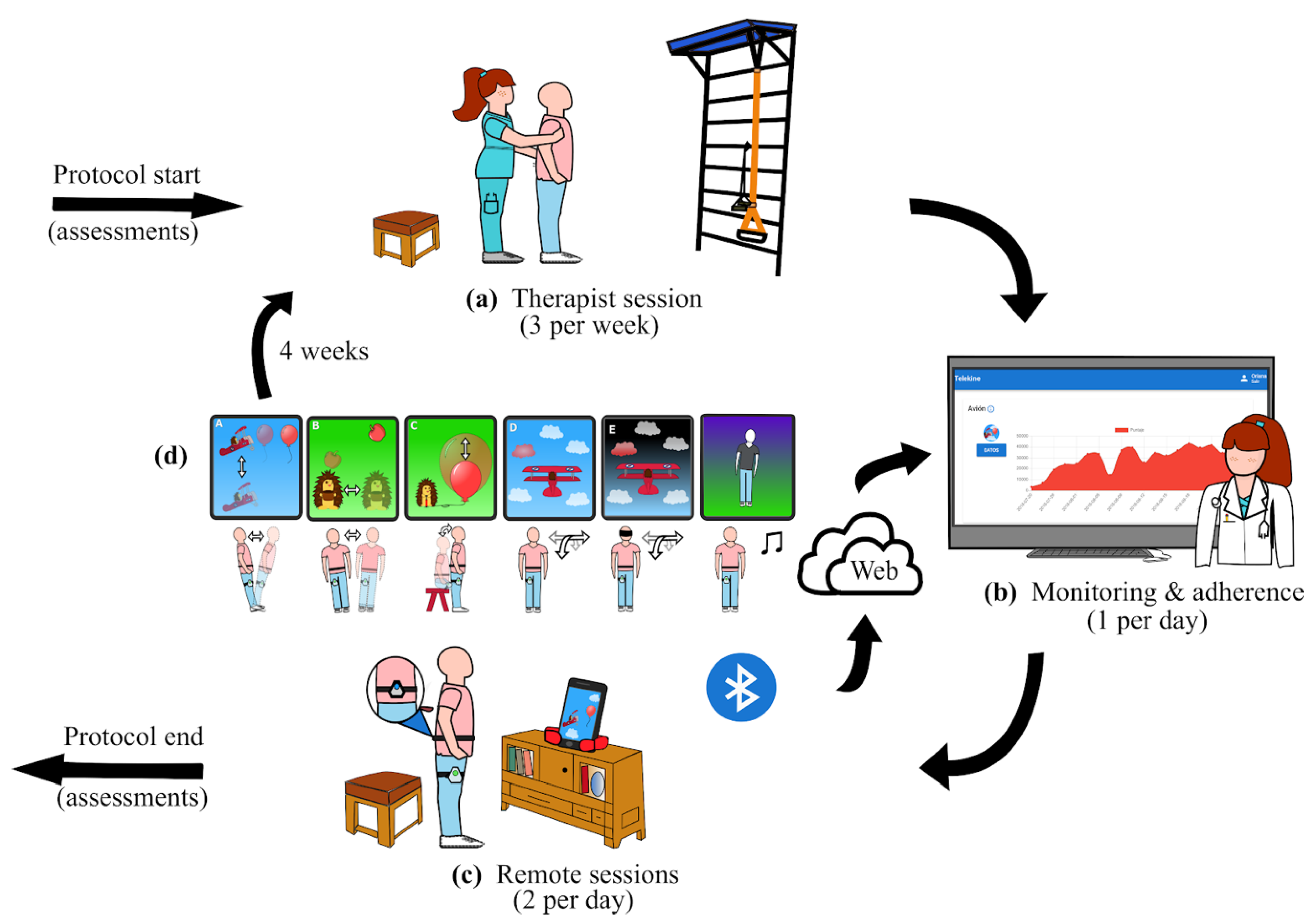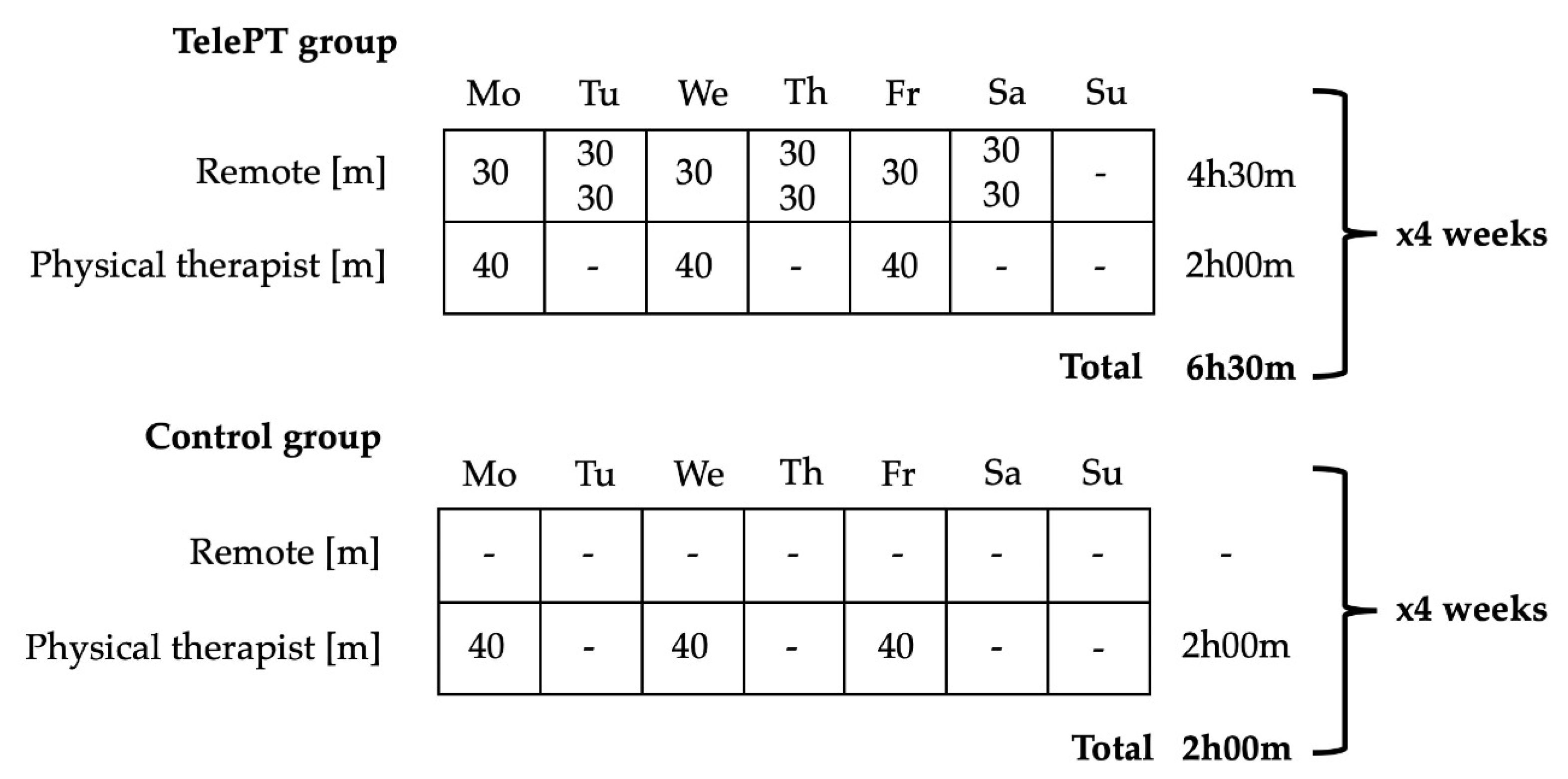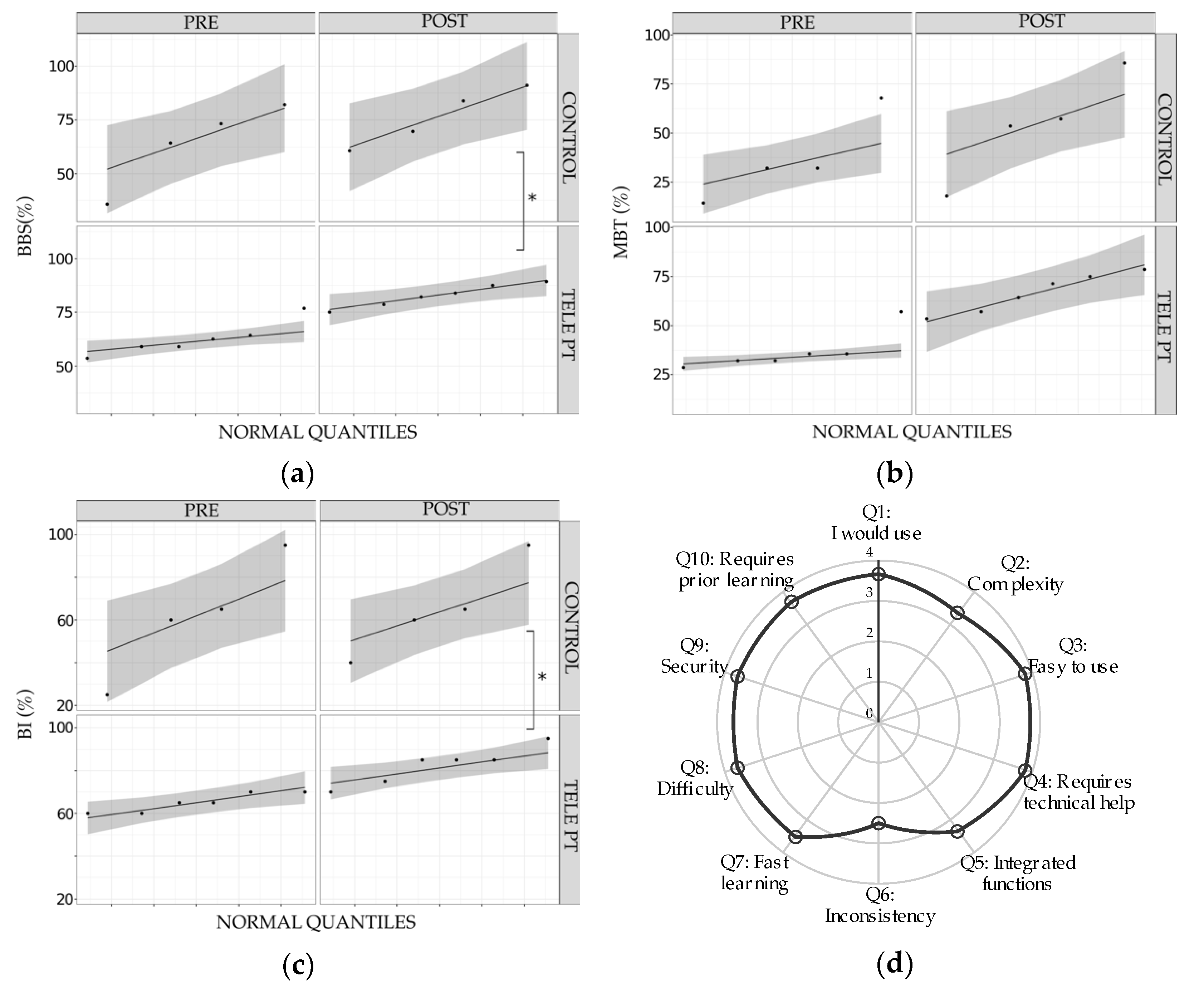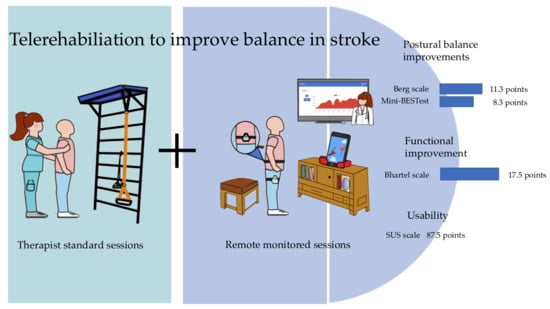Exergames and Telerehabilitation on Smartphones to Improve Balance in Stroke Patients
Abstract
:1. Introduction
2. Materials and Methods
2.1. Participants
2.2. Caregivers
2.3. Assessments
2.4. Telemedicine Equipment
2.5. Exergames
2.6. Clinical Protocol
2.7. Statistics
3. Results
3.1. Telerehabilitation Training Effects
3.2. Comparison with Conventional Treatment Results
3.3. User Experience
4. Discussion
5. Conclusions
Supplementary Materials
Author Contributions
Funding
Acknowledgments
Conflicts of Interest
References
- Feigin, V.L.; Krishnamurthi, R.V.; Parmar, P.; Norrving, B.; Mensah, G.A.; Bennett, D.A.; Barker-Collo, S.; Moran, A.E.; Sacco, R.L.; Truelsen, T.; et al. Update on the Global Burden of Ischemic and Hemorrhagic Stroke in 1990-2013: The GBD 2013 Study. Neuroepidemiology 2015, 45, 161–176. [Google Scholar] [CrossRef] [PubMed]
- Tyson, S.F.; Hanley, M.; Chillala, J.; Selley, A.; Tallis, R.C. Balance Disability after Stroke. Phys. Ther. 2006, 86, 30–38. [Google Scholar] [CrossRef] [PubMed]
- Rose, D.K.; DeMark, L.; Fox, E.J.; Clark, D.J.; Wludyka, P. A Backward Walking Training Program to Improve Balance and Mobility in Acute Stroke. J. Neurol. Phys. Ther. 2018, 42, 12–21. [Google Scholar] [CrossRef] [PubMed]
- Bernhardt, J.; Hayward, K.S.; Kwakkel, G.; Ward, N.S.; Wolf, S.L.; Borschmann, K.; Krakauer, J.W.; Boyd, L.A.; Thomas Carmichael, S.; Corbett, D.; et al. Agreed definitions and a shared vision for new standards in stroke recovery research: The Stroke Recovery and Rehabilitation Roundtable taskforce. Int. J. Stroke 2017, 12, 444–450. [Google Scholar] [CrossRef] [PubMed]
- Phelan, E.A.; Mahoney, J.E.; Voit, J.C.; Stevens, J.A. Assessment and Management of Fall Risk in Primary Care Settings. Med. Clin. N. Am. 2015, 99, 281–293. [Google Scholar] [CrossRef] [PubMed]
- WHO Global Report on Falls Prevention in Older Age 2007. Available online: https://www.who.int/ageing/publications/Falls_prevention7March.pdf (accessed on 11 October 2020).
- Tchero, H.; Tabue Teguo, M.; Lannuzel, A.; Rusch, E. Telerehabilitation for Stroke Survivors: Systematic Review and Meta-Analysis. J. Med. Internet Res. 2018, 20, e10867. [Google Scholar] [CrossRef] [PubMed]
- Laver, K.E.; Adey-Wakeling, Z.; Crotty, M.; Lannin, N.A.; George, S.; Sherrington, C. Telerehabilitation services for stroke. Cochrane Database Syst. Rev. 2020, 1, CD010255. [Google Scholar] [CrossRef] [PubMed]
- Sarfo, F.S.; Ulasavets, U.; Opare-Sem, O.K.; Ovbiagele, B. Tele-Rehabilitation after Stroke: An Updated Systematic Review of the Literature. J. Stroke Cerebrovasc. Dis. 2018, 27, 2306–2318. [Google Scholar] [CrossRef] [PubMed]
- Lin, K.-H.; Chen, C.-H.; Chen, Y.-Y.; Huang, W.-T.; Lai, J.-S.; Yu, S.-M.; Chang, Y.-J. Bidirectional and multi-user telerehabilitation system: Clinical effect on balance, functional activity, and satisfaction in patients with chronic stroke living in long-term care facilities. Sensors 2014, 14, 12451–12466. [Google Scholar] [CrossRef] [PubMed]
- Chen, J.; Jin, W.; Dong, W.S.; Jin, Y.; Qiao, F.L.; Zhou, Y.F.; Ren, C.C. Effects of Home-based Telesupervising Rehabilitation on Physical Function for Stroke Survivors with Hemiplegia: A Randomized Controlled Trial. Am. J. Phys. Med. Rehabil. 2017, 96, 152–160. [Google Scholar] [CrossRef] [PubMed]
- Lloréns, R.; Noé, E.; Colomer, C.; Alcañiz, M. Effectiveness, usability, and cost-benefit of a virtual reality-based telerehabilitation program for balance recovery after stroke: A randomized controlled trial. Arch. Phys. Med. Rehabil. 2015, 96, 418–425. [Google Scholar] [CrossRef] [PubMed]
- Bangor, A.; Kortum, P.T.; Miller, J.T. An Empirical Evaluation of the System Usability Scale. Int. J. Hum.-Comput. Interact. 2008, 24, 574–594. [Google Scholar] [CrossRef]
- Notch: Smart Motion Capture for Mobile Devices. Available online: https://wearnotch.com/ (accessed on 22 October 2020).
- R Core Team. Available online: https://www.r-project.org/ (accessed on 22 October 2020).
- Blum, L.; Korner-Bitensky, N. Usefulness of the Berg Balance Scale in stroke rehabilitation: A systematic review. Phys. Ther. 2008, 88, 559–566. [Google Scholar] [CrossRef] [PubMed]
- Bamford, J.; Sandercock, P.; Dennis, M.; Warlow, C.; Jones, L.; McPherson, K.; Vessey, M.; Fowler, G.; Molyneux, A.; Hughes, T. A prospective study of acute cerebrovascular disease in the community: The Oxfordshire Community Stroke Project 1981-86. 1. Methodology, demography and incident cases of first-ever stroke. J. Neurol. Neurosurg. Psychiatry 1988, 51, 1373–1380. [Google Scholar] [CrossRef] [PubMed]
- Noh, H.-J.; Lee, S.-H.; Bang, D.-H. Three-Dimensional Balance Training Using Visual Feedback on Balance and Walking Ability in Subacute Stroke Patients: A Single-Blinded Randomized Controlled Pilot Trial. J. Stroke Cerebrovasc. Dis. 2019, 28, 994–1000. [Google Scholar] [CrossRef] [PubMed]
- Godi, M.; Franchignoni, F.; Caligari, M.; Giordano, A.; Turcato, A.M.; Nardone, A. Comparison of reliability, validity, and responsiveness of the mini-BESTest and Berg Balance Scale in patients with balance disorders. Phys. Ther. 2013, 93, 158–167. [Google Scholar] [CrossRef] [PubMed]
- Mayo, N.E.; Nadeau, L.; Ahmed, S.; White, C.; Grad, R.; Huang, A.; Yaffe, M.J.; Wood-Dauphinee, S. Bridging the gap: The effectiveness of teaming a stroke coordinator with patient’s personal physician on the outcome of stroke. Age Ageing 2007, 37, 32–38. [Google Scholar] [CrossRef] [PubMed]
- Stevenson, T.J. Detecting change in patients with stroke using the Berg Balance Scale. Aust. J. Physiother. 2001, 47, 29–38. [Google Scholar] [CrossRef]
- Yang, C.M.; Wang, Y.-C.; Lee, C.-H.; Chen, M.-H.; Hsieh, C.-L. A comparison of test–retest reliability and random measurement error of the Barthel Index and modified Barthel Index in patients with chronic stroke. Disabil. Rehabil. 2020, 1–5. [Google Scholar] [CrossRef]
- Redzuan, N.S.; Engkasan, J.P.; Mazlan, M.; Freddy Abdullah, S.J. Effectiveness of a video-based therapy program at home after acute stroke: A randomized controlled trial. Arch. Phys. Med. Rehabil. 2012, 93, 2177–2183. [Google Scholar] [CrossRef]
- Krakauer, J.W.; Thomas Carmichael, S. Broken Movement: The Neurobiology of Motor Recovery After Stroke; MIT Press: Cambridge, MA, USA, 2017; ISBN 9780262037228. [Google Scholar]



| ID | S | A | Diagnostic 1 | Comorbidities | Drugs | BBS 2 | MBT 2 | BI 2 |
|---|---|---|---|---|---|---|---|---|
| TELE_PT 750352 | F | 62 | POCS/R/I/8 | Arterial Hypertension, Diabetes Mellitus type 2, High cholesterol | Losartan, Metformin, Atorvastatin, Aspirin | 33/44 | 9/15 | 60/95 |
| TELE_PT 981,283 | M | 46 | PACS/R/H/7 | Arterial Hypertension, Diabetes Mellitus type 2, Smoking, Dyslipidemia | Metformin, Atorvastatin | 35/47 | 9/20 | 65/85 |
| TELE_PT 798,056 | F | 62 | TACS/L/H/6 | Gastric Bypass (2015) | Sertraline | 30/42 | 8/18 | 60/75 |
| TELE_PT 361,739 | M | 63 | PACS/L/I/7 | Arterial Hypertension | Losartan | 33/50 | 10/22 | 70/85 |
| TELE_PT 194,267 | F | 54 | LACI/L/I/8 | Arterial Hypertension, Diabetes Mellitus type 2, Dyslipidemia | Losartan, Metformin, Insulin, Sertraline, Aspirin | 36/46 | 10/16 | 70/85 |
| TELE_PT 210,586 | M | 55 | POCS/L/I/7 | Arterial Hypertension, Diabetes Mellitus type 2 | Aspirin, Losartan, Metformin | 43/49 | 16/21 | 65/70 |
| CONTROL 955,948 | M | 62 | PACS/L/I/7 | Dyslipidemia | Aspirin, Atorvastatin | 46/51 | 19/24 | 95/95 |
| CONTROL 328,977 | M | 79 | LACS/R/I/7 | Dyslipidemia, Arterial Hypertension | Atorvastatin, Carvedilol | 41/47 | 9/15 | 60/65 |
| CONTROL 254,683 | M | 61 | PACS/R/I/6 | No | Aspirin | 20/34 | 4/5 | 25/40 |
| CONTROL 254,688 | F | 69 | PACS/R/I/6 | Dyslipidemia, Arterial Hypertension | Losartan | 36/39 | 9/16 | 65/60 |
| TELE PT PRE/POST Average | 35.00/46.33 | 10.33/18.67 | 65.00/ 82.50 | |||||
| CONTROL PRE/POST Average | 35.75/42.75 | 10.25/ 15.00 | 61.25/ 65.00 | |||||
Publisher’s Note: MDPI stays neutral with regard to jurisdictional claims in published maps and institutional affiliations. |
© 2020 by the authors. Licensee MDPI, Basel, Switzerland. This article is an open access article distributed under the terms and conditions of the Creative Commons Attribution (CC BY) license (http://creativecommons.org/licenses/by/4.0/).
Share and Cite
Burgos, P.I.; Lara, O.; Lavado, A.; Rojas-Sepúlveda, I.; Delgado, C.; Bravo, E.; Kamisato, C.; Torres, J.; Castañeda, V.; Cerda, M. Exergames and Telerehabilitation on Smartphones to Improve Balance in Stroke Patients. Brain Sci. 2020, 10, 773. https://doi.org/10.3390/brainsci10110773
Burgos PI, Lara O, Lavado A, Rojas-Sepúlveda I, Delgado C, Bravo E, Kamisato C, Torres J, Castañeda V, Cerda M. Exergames and Telerehabilitation on Smartphones to Improve Balance in Stroke Patients. Brain Sciences. 2020; 10(11):773. https://doi.org/10.3390/brainsci10110773
Chicago/Turabian StyleBurgos, Pablo I., Oriana Lara, Alejandro Lavado, Ignacia Rojas-Sepúlveda, Carolina Delgado, Eusebio Bravo, Cristian Kamisato, Julio Torres, Victor Castañeda, and Mauricio Cerda. 2020. "Exergames and Telerehabilitation on Smartphones to Improve Balance in Stroke Patients" Brain Sciences 10, no. 11: 773. https://doi.org/10.3390/brainsci10110773








